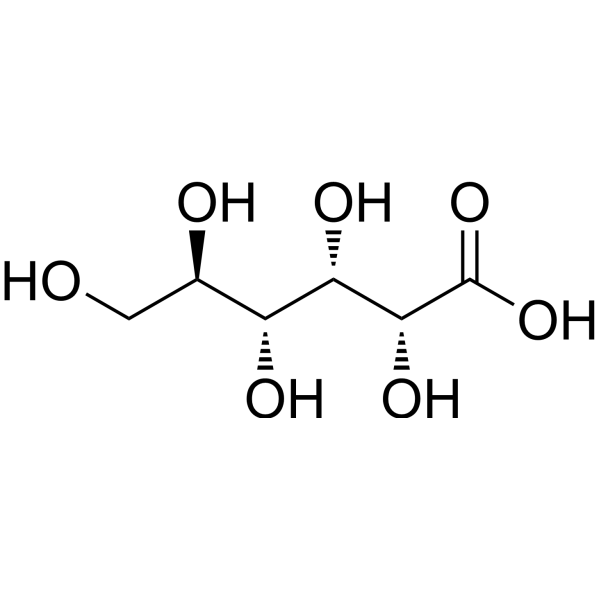
D-Gluconic acid
CAS No. 526-95-4
D-Gluconic acid( Gluconic acid | Dextronic acid | Maltonic acid | Glycogenic acid | Pentahydroxycaproic acid | D-Gluco-hexonic acid | D-Gluconsaeure )
Catalog No. M26138 CAS No. 526-95-4
D-gluconic acid is a carboxylic acid that has antiseptic and chelating properties through oxidation.
Purity : >98% (HPLC)
 COA
COA
 Datasheet
Datasheet
 HNMR
HNMR
 HPLC
HPLC
 MSDS
MSDS
 Handing Instructions
Handing Instructions
| Size | Price / USD | Stock | Quantity |
| 100MG | Get Quote | Get Quote |


|
| 200MG | Get Quote | Get Quote |


|
| 500MG | Get Quote | Get Quote |


|
| 1G | Get Quote | Get Quote |


|
Biological Information
-
Product NameD-Gluconic acid
-
NoteResearch use only, not for human use.
-
Brief DescriptionD-gluconic acid is a carboxylic acid that has antiseptic and chelating properties through oxidation.
-
DescriptionD-gluconic acid is a carboxylic acid that has antiseptic and chelating properties through oxidation.(In Vitro):D-gluconic acid (a simple sugar acid) is the most important antifungal metabolite produced by Pseudomonas. Channel AN5 has a biological control effect against all fungal pathogens.
-
In VitroD-gluconic acid, a simple sugar acid, is the most significant antifungal metabolite produced by Pseudomonas. str. AN5 against the take-all fungal pathogen in biocontrol protection.
-
In Vivo——
-
SynonymsGluconic acid | Dextronic acid | Maltonic acid | Glycogenic acid | Pentahydroxycaproic acid | D-Gluco-hexonic acid | D-Gluconsaeure
-
PathwayOthers
-
TargetOther Targets
-
Recptor——
-
Research Area——
-
Indication——
Chemical Information
-
CAS Number526-95-4
-
Formula Weight196.155
-
Molecular FormulaC6H12O7
-
Purity>98% (HPLC)
-
SolubilityIn Vitro:?H2O : 100 mg/mL (509.79 mM)
-
SMILESOC[C@@H](O)[C@@H](O)[C@H](O)[C@@H](O)C(O)=O
-
Chemical Name——
Shipping & Storage Information
-
Storage(-20℃)
-
ShippingWith Ice Pack
-
Stability≥ 2 years
Reference
1.Hanson RL, Isaacson CM. Stimulation of insulin secretion from isolated rat islets by SaRI 59-801. Relation to cAMP concentration and Ca2+ uptake. Diabetes. 1985 Jul;34(7):691-5. PubMed PMID: 2408949.
molnova catalog



related products
-
DSPE-PEG 2000
DSPE-PEG 2000 is a non-toxic and biodegradable amphiphilic copolymer that can be used to form micelles to deliver nanoparticles.
-
HBV polymerase (455 ...
HBV polymerase (455 - 463)
-
Sepin-1
Sepin-1 is a noncompetitive inhibitor of separase with an IC50 of 14.8 μM. Sepin-1 can inhibit the growth of breast cancer xenograft tumors in mice and human cancer cell lines by inhibiting cell proliferation and inducing apoptosis.



 Cart
Cart
 sales@molnova.com
sales@molnova.com


